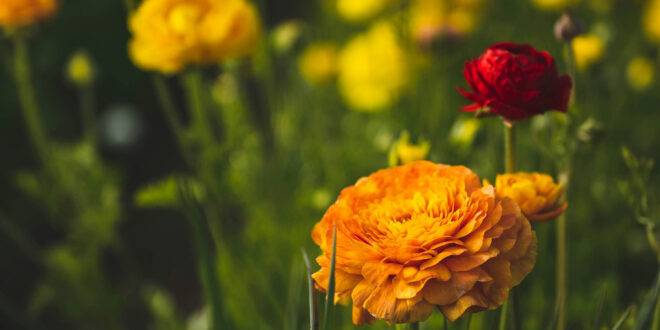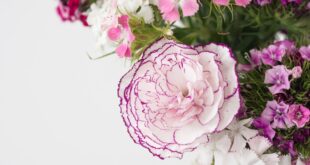As with all good things, we need to plan ahead to make them happen, and some of the most treasured of spring flowers are no exception. Feathery ranunculus, fragile anemone, and hairy pulsatilla, all require our attention this month if they are to flower come late August, September, or even October, depending on where in the country you live. But the effort is well worth the colour, so here’s how to go about getting it:
Anemone and ranunculus
If you have ever visited Greece in early spring, one of the first wildflowers you will have noticed, poking up from patches of thawing snow, is the anemone. Also known as ‘the windflower,’ the purple, red, and sometimes pale lemon blooms, are associated with the Greek myth of Adonis from whose blood, the red anemone was said to have sprung up.
Rather than growing from a bulb, the anemone’s life force resides in a dry, cone-shaped corm which is pointed at one end. It is the pointed end of the corm which should be planted downwards into the ground.
Brightly coloured ranunculus come in both double and single varieties, and are one of the most popular spring flowering plants for picking (if you enjoy flowers indoors, in a vase, look for varieties that boast strong stems, or pop the blooms into a vase of foliage or dried Gypsophila where they will receive plenty of support). Ranunculus corms have a distinct claw-shape to them, with the dry claws being connected to a central crown. When planting, ensure the claws face downward.
Anemone and ranunculus both have the same requirements when it comes to soil. Unless you make your own rich compost (with added fine grit for drainage), choose a bulb mix for your growing medium. Or create your own with loose, organic soil, river sand, and bulb fertilizer (added according to the instructions on the container). Lime homemade growing mediums at a rate of around 100-200 grams per square metre.
Plant the corms 5 to 6 cm deep, and keep the soil damp but not wet. Once the corms flower, feed with liquid manure every couple of weeks. Ensuring the ground stays damp will extend the flowering.
Pulsatilla
Because pulsatilla are often grown in association with the earliest of spring flowers (some flowering even as early as snowdrops), we tend to think they should be planted in the same way. But pulsatilla (which are close relatives of anemone), actually grow by the division of the plant’s woody crown, rather than by bulb or corm.
The pulsatilla’s common name is ‘pasque flower.’ Pasque is a French word for ‘Easter,’ and in the Northern Hemisphere, Easter equates to spring. In New Zealand, it’s September we enjoy these soft, purple, lavender, and white flowers peeping out of serrated, olive-green foliage. When you do spot pulsatilla, they are more than likely to be growing in a rock garden, which is a clue to the situation and soil they like best – dry, sunny, well-drained, and with plenty of fine grit incorporated into only very lightly fertilized, chalky, loam.
If you have a friend with pulsatilla clumps well established, they may be willing to share some divisions with you. However, if you go down this route, be aware you may not get a flower from your pulsatilla next spring, and rather, have to wait for the following spring for your treat. In which case, why not shout yourself a pulsatilla plant or two from a nursery, as well, so you can enjoy a bloom as soon as possible.
Spring comes only once a year. To make the most of it, prepare your garden by planting these beautiful, delicate early flowering treasures right now!










Join the Discussion
Type out your comment here:
You must be logged in to post a comment.